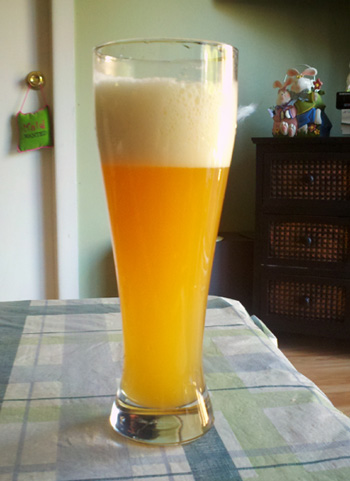rdann87
Well-Known Member
Hey guys,
So we are planning on brewing a Wheat beer from extract tomorrow. 5 gallon batch, unfortunately we don't have the tools to do a full boil though. So our boil will only be 3 gallons and we will make up for the rest with distilled water in the fermentor.
What we were planning on doing for the sake of experimenting was adding some orange flavor to it.
The kit we are using is a True Brew American Wheat Kit (unfortunately i can't find the specifics on exactly what is in the kit).
We did a bunch of research online and decided the best method would probably be going with blood oranges.
Our plan is to zest about 4 oranges and boil the zest for the last 5 minutes in the boil. The guy at our LHBS also suggested that we steep some more zest and a few slices of the actual oranges themselves to the secondary fermentor and leave them in there for about 10 days. He suggested that we poke the oranges with some tooth picks before putting them in.
What are your guys thoughts on this one? We are obviously hoping for the sweet orange taste, as opposed to the bitter taste from the rind. We were told that we may want to skip adding the oranges and instead add freshly squeezed juice.
We were also told that adding oranges to the secondary may require us to re-pitch some more yeast.
Any suggestions/ comment?
Thanks
So we are planning on brewing a Wheat beer from extract tomorrow. 5 gallon batch, unfortunately we don't have the tools to do a full boil though. So our boil will only be 3 gallons and we will make up for the rest with distilled water in the fermentor.
What we were planning on doing for the sake of experimenting was adding some orange flavor to it.
The kit we are using is a True Brew American Wheat Kit (unfortunately i can't find the specifics on exactly what is in the kit).
We did a bunch of research online and decided the best method would probably be going with blood oranges.
Our plan is to zest about 4 oranges and boil the zest for the last 5 minutes in the boil. The guy at our LHBS also suggested that we steep some more zest and a few slices of the actual oranges themselves to the secondary fermentor and leave them in there for about 10 days. He suggested that we poke the oranges with some tooth picks before putting them in.
What are your guys thoughts on this one? We are obviously hoping for the sweet orange taste, as opposed to the bitter taste from the rind. We were told that we may want to skip adding the oranges and instead add freshly squeezed juice.
We were also told that adding oranges to the secondary may require us to re-pitch some more yeast.
Any suggestions/ comment?
Thanks



 But this is not quite correct. It is not food for the mother plant, it is rarely food for the seed. It is mainly for protection of the seed and for getting birds and other animals to eat it and poop the seeds out elsewhere so there is no competition near the mother tree.
But this is not quite correct. It is not food for the mother plant, it is rarely food for the seed. It is mainly for protection of the seed and for getting birds and other animals to eat it and poop the seeds out elsewhere so there is no competition near the mother tree.
